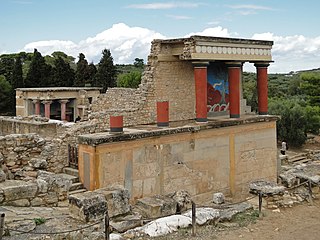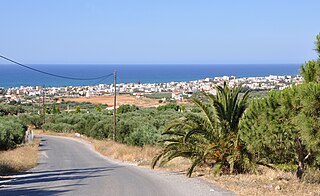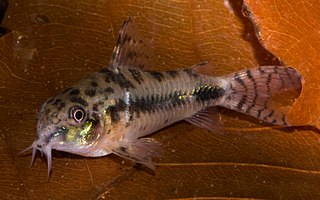
Crete is the largest and most populous of the Greek islands, the 88th largest island in the world and the fifth largest island in the Mediterranean Sea, after Sicily, Sardinia, Cyprus, and Corsica. Crete and a number of surrounding islands and islets constitute the region of Crete, one of the 13 top-level administrative units of Greece. The capital and the largest city is Heraklion. As of 2011, the region had a population of 623,065.

Linear A is a writing system used by the Minoans (Cretans) from 2500 to 1450 BC. Along with Cretan hieroglyphic, it is one of two undeciphered writing systems used by ancient Minoan and peripheral peoples. Linear A was the primary script used in palace and religious writings of the Minoan civilization. It was discovered by archaeologist Sir Arthur Evans. It is related to the Linear B script, which succeeded the Linear A and was used by the Mycenaean civilization.

The Minoan civilization was a Bronze Age Aegean civilization on the island of Crete and other Aegean Islands which flourished from c. 2700 to c. 1450 BC, before a late period of decline, finally ending around 1100 BC. It preceded and was absorbed by the Mycenaean civilization of ancient Greece. The civilization was rediscovered at the beginning of the 20th century through the work of British archaeologist Arthur Evans. The name "Minoan" derives from the mythical King Minos and was coined by Evans, who identified the site at Knossos with the labyrinth and the Minotaur. The Minoan civilization has been described as the earliest of its kind in Europe, with historian Will Durant calling the Minoans "the first link in the European chain".

In Greek mythology, Rhadamanthus or Rhadamanthys was a wise king of Crete. In later accounts he is said to be one of the judges of the dead.

Knossos is the largest Bronze Age archaeological site on Crete and has been called Europe's oldest city.

The Greco-Turkish War of 1897, also called the Thirty Days' War and known in Greece as the Black '97 or the Unfortunate War, was a war fought between the Kingdom of Greece and the Ottoman Empire. Its immediate cause was the question over the status of the Ottoman province of Crete, whose Greek majority long desired union with Greece. Despite the Ottoman victory on the field, an autonomous Cretan State under Ottoman suzerainty was established the following year, with Prince George of Greece and Denmark as its first High Commissioner.

The University of Crete is a multi-disciplinary, research-oriented institution in the island of Crete, Greece, located in the cities of Rethymnon and Heraklion, and one of the country's most academically acclaimed and reputable ones.

The Vancouver Aquarium is a public aquarium located in Stanley Park in Vancouver, British Columbia, Canada. In addition to being a major tourist attraction for Vancouver, the aquarium is a centre for marine research, conservation and marine animal rehabilitation.

Mount Ida, known variously as Idha, Ídhi, Idi, Ita and now Psiloritis, at 2,456 m, is the highest mountain on Crete. Located in the Rethymno regional unit, it was sacred to the Greek Titaness Rhea, and on its slopes lies one of the caves, Idaion Antron, in which, according to legend, Zeus was born. Its summit has the highest topographic prominence in Greece. A natural park which includes Mt. Ida is a member of UNESCO's Global Geoparks Network.

Gouves is a town and former municipality in the Heraklion regional unit, Crete, Greece. Since the 2011, local government reform it is part of the municipality Hersonissos, of which it is a municipal unit. The municipal unit has an area of 94.963 km2 (36.665 sq mi). It lies a few kilometers east of Heraklion.

The salt and pepper catfish is a tropical freshwater fish belonging to the Corydoradinae sub-family of the family Callichthyidae. It originates in inland waters in South America, and is found in the Upper Orinoco River basin in Venezuela and Colombia.
Preveli is a location on the south coast of the Greek island of Crete, in the Rethymno regional unit, notable for its historic monastery.

The Cretan shrew is a species of mammal in the family Soricidae. It is endemic and exclusive to the island of Crete, Greece. Its natural habitat is temperate shrubland, and the animal is threatened by habitat loss. It is found in the mountainous highlands of Crete, having been displaced from lower altitudes by the lesser white-toothed shrew.

The Cretan State, was established in 1898, following the intervention by the Great Powers on the island of Crete. In 1897, an insurrection in Crete headed by the Ottoman Empire to declare war on Greece, which led Great Britain, France, Italy and Russia to intervene on the grounds that the Ottoman Empire could no longer maintain control. It was the prelude to the island's final annexation to the Kingdom of Greece, which occurred de facto in 1908 and de jure in 1913.

Ceto, is a primordial sea goddess in Greek mythology, the daughter of Gaia and Pontus. As a mythological figure, she is most notable for bearing by Phorcys a host of monstrous children. The small solar system body 65489 Ceto was named after her, and its satellite after Phorcys.

Cretaquarium or Thalassocosmos is a public aquarium located near the town of Gournes in Crete, Greece, 15 km east of the city of Heraklion.

Ha Gorge is a narrow gorge, at the Monasteraki Dakos, on the eastern part of the island of Crete in Greece. It is located in the west slope of Thrypti mountain range, and exits east of Vasiliki village in the plain of Ierapetra. From this location scenic views overlook Pahia Amos and the bay. Being practically inaccessible to people, the gorge maintains a rich and diverse flora and fauna. Its depth is about 1,000 metres (3,300 ft) and the fissure is said to be one of the largest in the world. Late Minoan IIIC sites are in the area.

The Razing of Anogeia or the Holocaust of Anogeia refers to the complete destruction of the village of Anogeia in central Crete (Greece) and the murder of about 25 of its inhabitants on 13 August 1944 by German occupying forces during World War II. This was the third time Anogeia was destroyed, as the Ottomans had destroyed it twice; first in July 1822 and again in November 1867, during the Great Cretan Revolt.



















